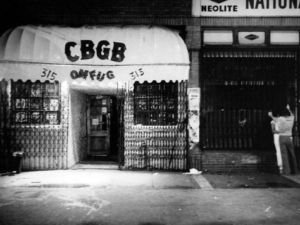
This song represents the artistic spirit of the downtown village scene; its use of aesthetic irony combines the visions of art as reflective and transformative, illuminating the motivations of the time. Patti Smith recounts this song as a small prophecy, as a friend had given a record of it to her after she was disheartened by her cold reaction to the Doors, one of the bands she idolized, and said it was going to be important to her (59-60). However, this song is not only representative of the village scene because it divines Patti Smith’s success as a leader in the punk movement, but because its lyrics reflect the counterculture spirit, while its music imitates the mainstream, subverting it through its own form.
The lyrics mock the popular culture of the time, the antithesis of the village artists’ individualism. They give ironic advice about how to become a rock ‘n’ roll star, mocking the mainstream’s focus on homogeneity and commercialism. The mainstream addresses similar themes as the village artists, like sexuality and the price of recognition, but without the focus on individuality that distinguishes punk rock and other art forms of the time. Mainstream music is not about the expression of someone’s true feelings, but “the money, the game and the public acclaim.” You have to “sell your soul to the company/ who are waiting there to sell plasticware.” Plasticware is mass produced and marketed towards families, often sold at tupperware parties held by a friend or neighbor. This suggests that the companies, like those selling tupperware, try to seem friendly, but are ultimately after profit. Additionally, despite the open expression of sexuality by the members of these bands, with their “hair swung right” and their “pants too tight” so the “girls’ll tear [them] apart,” it is all still family-friendly and suitable for the mass-market. Their expression of sexuality isn’t an expression of individuality, but a carefully curated tool meant to influence the public. It humanized and homogenized them. In the counterculture scene, however, the mainstream barriers around sex and sexuality were meant to be broken, as evidenced by Patti Smith’s androgyny and Robert Mapplethorpe’s S&M photography. In popular culture, expressions of sex and sexuality served to enforce existing barriers, so the counterculture artists directly break expectations. To be an artist was to be free, to be who you are but also to distinguish yourself. In this way, by rebelling against the mainstream that the lyrics mock, the artists of the period attempted to transform the world.
However, art of the time also sought to influence the world by reflecting it. The music of the song does just that. While the lyrics critique mainstream music, the music imitates it. It is bright and bouncy, conforming to the 2-3 minute time constraint typical of pop music. The tempo is constant and melodies repeat in a predictable way. The repetition is a bridge between genres, as it is meant to be catchy in mainstream music and trancelike in punk rock. In this song, the critique is made more powerful and receivable by the use of popular music’s own form. Without listening closely to the lyrics, one might think that the song is an emulation of the mainstream, making the irony of the lyrics more potent. The social critique is more receivable because the song is catchy. It makes it possible for it to infiltrate the mainstream, reaching the people they need to convince. One comparable artist from the 60s and 70s is Andy Warhol, who mass-produced artistic representations of popular figures and icons, like Marilyn Monroe and Campbell’s Tomato Soup, in “The Factory.” His works merge art and the mass-production typical of consumer culture, possibly critiquing both. He reflects the world, but it is ironic because it is framed as art. He critiques the pretentious part of art as individual expression by mass producing it, and consumerism by associating it with art, which is generally seen as elevated. Both are ironic in their association to each other.
The incongruence between the melody and the lyrics is representative of the village spirit because it reflects their use of aesthetic irony. Patti Smith, in her memoir Just Kids, critiques Andy Warhol, saying that “his work reflected a culture I wanted to avoid. I hated the soup and felt little for the can. I preferred an artist who transformed his time, not mirrored it” (Smith, 69). While Smith draws a sharp line between these visions, the use of aesthetic irony combines them. These artists frame their social critique with the positive lens of art, as the song frames the lyrics with a happy, mainstream melody. Their reflection of the world is ironic, meant to subvert it. They critique mainstream culture while imitating it to some degree, demonstrating an understanding of it that validates their critique. It situates them as outsiders by choice, not outcasts. The use of aesthetic irony during the time seems to better reflect Richard Hell’s vision of art, which he describes in a personal journal as a “method for believing in the worth of life that doesn’t exclude the horror.” They don’t only reflect the world and what’s wrong with it, but seek to transform it by doing so. The nature of art tinges their social critiques with hope for change in the future.